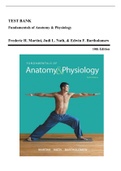Exam (elaborations)
Test Bank - Fundamentals of Anatomy & Physiology, 10th Edition (Martini, 2015), Chapter 1-29 | All Chapters
- Course
- Institution
- Book
Test Bank - Fundamentals of Anatomy & Physiology, 10th Edition (Martini, 2015), Chapter 1-29 | All Chapters
[Show more]



